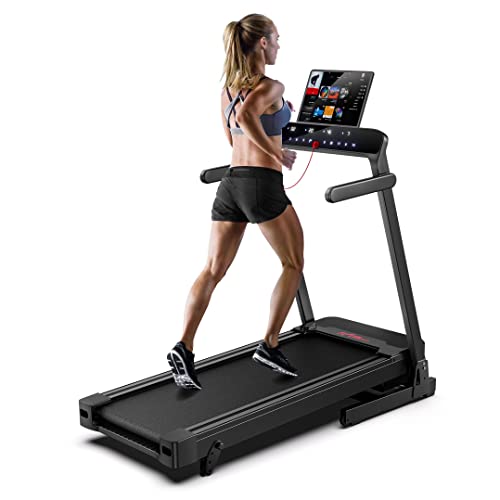Treadmills: A Comprehensive Guide to Understanding Their Functionality, Benefits, and Appropriate Selection
Introduction
Treadmills have become a staple in modern-day fitness regimens, both in homes and health clubs worldwide. They provide a convenient and efficient method to keep cardiovascular health, boost endurance, and help in weight management. This short article explores the various types of treadmills, their benefits, functions to think about when acquiring, and some FAQs to assist users in making informed decisions.
Types of Treadmills
When it pertains to picking a treadmill, it is crucial to understand the various types available in the market. Here are the main classifications:
1. Manual Treadmills
- Mechanism: These treadmills have a basic design and count on the user's efforts to move the belt.
- Pros: More budget-friendly, quieter operation, no electricity needed.
- Cons: Limited functions, may not offer the very same variety of exercise intensity.
2. Motorized Treadmills
- Mechanism: Powered by a motor that drives the belt, permitting users to walk or perform at a set pace.
- Pros: Greater range of speeds and inclines, equipped with various features such as heart rate displays and exercise programs.
- Cons: More costly and might need more upkeep.
3. Folding Treadmills
- System: Designed for those with minimal space, these treadmills can be folded for easy storage.
- Pros: Space-saving, often motorized, versatile features.
- Cons: May be less resilient than non-folding designs.
4. Commercial Treadmills
- Mechanism: High-quality machines created for use in gyms and gym.
- Pros: Built to withstand heavy use, advanced features, typically include service warranties.
- Cons: Pricey and not ideal for home usage due to size.
5. Curved Treadmills
- System: A distinct style that permits users to move the belt utilizing their own energy.
- Pros: Offers a more natural running experience, promotes better running type.
- Cons: More expensive and can be noisier.
| Treadmill Type | Pros | Cons |
|---|---|---|
| Manual | Inexpensive, no electricity needed | Restricted features |
| Motorized | Range of speeds, advanced functions | Maintenance needed |
| Folding | Space-saving, often motorized | May lack toughness |
| Business | Developed to last, professional-grade functions | Costly |
| Curved | Natural running experience, promotes great kind | Higher cost |
Benefits of Using Treadmills
Treadmills offer many advantages that can contribute to one's overall health and fitness goals. A few of these benefits consist of:
- Convenient Workouts: Treadmills allow users to work out inside regardless of weather.
- Cardiovascular Health: Regular use can improve heart health by increasing stamina and promoting healthy flow.
- Weight Management: Effective for burning calories, which aids in weight loss and management.
- Personalized Workouts: Users can control speed, incline, and period to create tailored workout experiences.
- Safety: Treadmills supply a foreseeable surface, minimizing the threat of falls compared to outdoor running.
- Multifunctional: Many treadmills featured features like heart rate displays, exercise programs, and even entertainment systems.
Picking the Right Treadmill
When selecting a treadmill, possible buyers must think about numerous key elements:
Features to Consider:
- Motor Power: Typically measured in horsepower (HP), a motor strength of a minimum of 2.5 HP is suggested for major runners.
- Belt Size: A longer and wider belt accommodates numerous stride lengths, offering convenience throughout exercises.
- Incline Settings: Adjustable slope features simulate outside hill running and can increase workout strength.
- Weight Capacity: Ensure the treadmill can support the user's weight for safety and longevity.
- Console Features: Look for easy to use control panels, workout programs, and Bluetooth compatibility for streaming music or other functions.
Budget Considerations
- Under ₤ 500: Entry-level manual treadmills suitable for casual walkers.
- ₤ 500 - ₤ 1,500: Mid-range motorized treadmills that offer more functions and much better sturdiness.
- ₤ 1,500 - ₤ 3,000: High-end models with sophisticated technology, bigger motors, and longer service warranties.
- Over ₤ 3,000: Commercial-grade treadmills perfect for frequent usage in fitness centers or training centers.
Often Asked Questions (FAQs)
1. How frequently should I utilize a treadmill?
It is advised to utilize a treadmill at least 3 to 5 times a week, integrating numerous strength levels for best outcomes.
2. Can view lose weight by utilizing a treadmill?
Yes, consistent usage of a treadmill can add to weight loss, particularly when integrated with a well balanced diet and strength training.
3. What is the best speed to stroll on a treadmill for novices?
A speed of 3 to 4 miles per hour is an ideal variety for novices. It's necessary to begin slow and gradually increase pace as convenience and endurance enhance.
4. Do I require to utilize a treadmill if I already run outdoors?
Using a treadmill can provide fringe benefits, such as regulated environments and varied exercises (incline, periods) that are not always possible outdoors.
5. How do I maintain my treadmill?
Regular upkeep consists of lubing the belt, cleaning the deck and console, and checking the motor for ideal performance.
Treadmills are necessary tools for those aiming to boost their physical fitness levels in a regulated and hassle-free manner. With various types readily available, comprehending their features and benefits is essential for making a notified purchase. By considering individual exercise needs, space schedule, and budget constraints, people can find the most suitable treadmill that fits their way of life. Incorporating treadmill exercises into a balanced physical fitness routine can lead to improved health results and an enjoyable workout experience.

